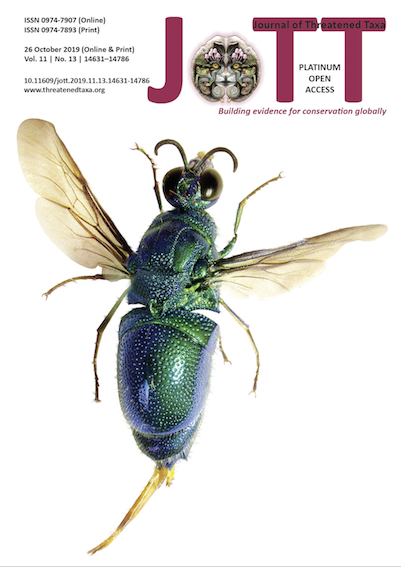Mammal diversity in a montane forest in central Bhutan
DOI:
https://doi.org/10.11609/jott.5058.11.13.14757-14763Keywords:
Biodiversity, camera trap, Himalaya, protected areas, threatened speciesAbstract
In Bhutan, knowledge of wildlife species richness in protected areas is increasing, particularly for mammals; however, the knowledge outside of protected areas typically remains poor. We conducted a camera trap survey from May 2016 to July 2017 in a montane forest outside of the protected areas network in central Bhutan and recorded 15 species of mammals (belonging to nine families and three orders), of which nearly half were listed as Endangered, Vulnerable, or Near Threatened. Our findings demonstrate that forested landscapes outside protected areas in Bhutan support a rich assemblage of wildlife species and are, therefore, deserving of comprehensive wildlife conservation plans and dedicated funding for ecological research and threat mitigation.
References
Dhendup, T. & R. Dorji (2018a). Camera-trap records of small carnivores from Gedu Territorial Forest Division, Bhutan. Small Carnivore Conservation 56: 1–6.
Dhendup, T. & R. Dorji (2018b). Occurrence of six felid species outside protected areas in western Bhutan. Cat News 67: 37–39.
DOFPS (2015). Counting the Tigers in Bhutan: Report on the National Tiger Survey of Bhutan 2014–2015. Department of Forest and Park Services. Thimphu, Bhutan, ix+60pp.
DOFPS (2016). National Snow Leopard Survey of Bhutan 2014–2016 (Phase II): Camera Trap Survey for Population Estimation. Department of Forest and Park Services. Thimphu, Bhutan, xviii+65pp.
Gompper, M.E., R.W. Kays, J.C. Ray, S.D. LaPoint, D.A. Bogan & J.R. Cryan (1999). A comparison of noninvasive techniques to survey carnivore communities in northeastern North America. Wildlife Society Bulletin 34: 1142–1151.
Hedwig, D., I. Kienast, M. Bonnet, B.K. Curran, T. King, A. Courage, C. Boesch, H.S. Kuhl & T. King (2018). A camera trap assessment of the forest mammal community within the transitional savannah-forest mosaic of the Bateke Plateau National Park, Gabon. African Journal of Ecology 56(4): 777–790. https://doi.org/10.1111/aje.12497
Hodge, A.M.C & B.S. Arbogast (2016). Carnivore diversity at a montane rainforest site in Ecuador’s Gran Sumaco Biosphere Reserve. Oryx 50: 474–479.
Jenks, K.E., P. Chanteap, K. Damrongchainrong, P. Cutter, P. Cutter, T. Redford, A.J. Lynam, J. Howard & P. Leimburger (2011). Using relative abundance indices from camera-trapping to test wildlife conservation hypotheses – an example from Khao Yai National Park, Thailand. Tropical Conservation Science 4: 113–131.
Mittermeier, R.A., P.R. Gil, M. Hoffmann, J. Pilgrims, T. Brooks, C.G. Mittermeier, J. Lamoreux & G.A.B. Da Fonseca (2004). Hotspots Revisited: Earth’s Biologically Richest and Most Endangered Terrestrial Ecoregions. CEMEX, USA, 391pp.
Moo, S.S.B., G.Z.L. Froeze & T.N.E. Gray (2017). First structured camera-trap surveys in Karen State, Myanmar, reveal high diversity of globally threatened mammals. Oryx 52(3): 537–543.
NEC (2011). Biodiversity. National Environment Commission, Thimphu, Bhutan, 33pp.
O’Brien, T.G.O. (2011). Abundance, density and relative abundance: a conceptual framework, pp. 71–96. In: O’Connell, A.F., J.D. Nichols & U.K. Karanth (eds.). Camera Traps in Animal Ecology. Springer, Tokyo, xiv+271pp.
Olson, D.M. & E. Dinerstein (2002). The Global 200: Priority ecoregions for global conservation. Annals of the Missouri Botanical Garden 89(2): 199–224.
Pearl, H., N. Bonney, J. Whitehead, T. Rhodes, I.H. Simpson, R. Singye & C.L. Gross (2015). Plant species richness, structure and life form respond to an altitudinal gradient in central Bhutan, eastern Himalayas. Journal of Bhutan Ecological Society 2: 66–90.
Penjor, U., D.W. MacDonald, S. Wangchuck, T. Tandin & C.K.W. Tan (2018). Identifying important conservation areas for the Clouded Leopard Neofelis nebulosa in a mountainous landscape: Inference from spatial modeling techniques. Ecology and Evolution 8: 4278–4291.
Rovero, F., E. Martin, M. Rosa, J.A. Ahumada & D. Spitale (2014). Estimating species richness and modelling habitat preferences of tropical forest mammals from camera trap data. PLoS ONE 9(10): e110971. https://doi.org/10.1371/journal.pone.0110971
Sanderson, J.G. & G. Harris (2013). Automatic data organization, storage, and analysis of camera trap pictures. Journal of Indonesian Natural History 1: 11–19.
Tempa, T., M. Hebblewhite, L.S. Mills, T.R. Wangchuk, N. Norbu, T. Wangchuk, T. Nidup, P. Dendup, D. Wangchuk, Y. Wangdi & T. Dorji (2013). Royal Manas National Park, Bhutan: a hot spot for wild felids. Oryx 47: 207–210.
Thinley, P., T. Dorji, S. Phuntsho, N. Dorji & P. Dorji (2015). Estimating wild Tiger (Panthera tigris Linnaeus) abundance and density using a spatially-explicit capture-recapture model in Jigme Dorji National Park, Bhutan. Bhutan Journal of Natural Resources and Development 2: 1–10.
Wang, S.W. & D.W. MacDonald (2009). The use of camera traps for estimating tiger and leopard populations in the high altitude mountains of Bhutan. Biological Conservation 142: 606–613.
Wangchuk, T., P. Thinley, K. Tshering, C. Tshering, D. Yonton & B. Pema (2004). Mammals of Bhutan. Department of Forest and Park Services, Thimphu, Bhutan, 180pp.
WCNP & WWF (2016). Population Status and Distribution of Snow Leopards in Wangchuck Centennial National Park, Bhutan. Department of Forest and Park Services, Thimphu, Bhutan, 35pp.
Published
Issue
Section
License
Authors own the copyright to the articles published in JoTT. This is indicated explicitly in each publication. The authors grant permission to the publisher Wildlife Information Liaison Development (WILD) Society to publish the article in the Journal of Threatened Taxa. The authors recognize WILD as the original publisher, and to sell hard copies of the Journal and article to any buyer. JoTT is registered under the Creative Commons Attribution 4.0 International License (CC BY), which allows authors to retain copyright ownership. Under this license the authors allow anyone to download, cite, use the data, modify, reprint, copy and distribute provided the authors and source of publication are credited through appropriate citations (e.g., Son et al. (2016). Bats (Mammalia: Chiroptera) of the southeastern Truong Son Mountains, Quang Ngai Province, Vietnam. Journal of Threatened Taxa 8(7): 8953–8969. https://doi.org/10.11609/jott.2785.8.7.8953-8969). Users of the data do not require specific permission from the authors or the publisher.





